Evidence for a rapid decrease of Pluto’s atmospheric pressure revealed by a stellar occultation in 2019 (Arimatsu et al.)
- Details
- Published on 15 June 2020
Vol. 638
1. Letters
Evidence for a rapid decrease of Pluto’s atmospheric pressure revealed by a stellar occultation in 2019
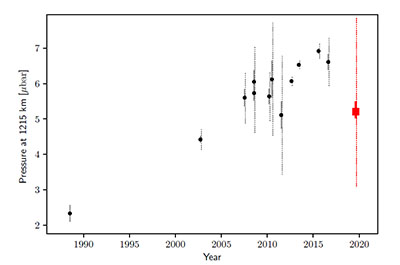
Pluto's atmosphere originates from sublimation-condensation equilibria of surface volatiles, primarily N2. Pluto's strongly elliptical orbit and high obliquity lead to marked seasonal variability of the local insolation. Regular monitoring of stellar occultations over the last 30 years has revealed that although Pluto has been receding from the Sun since 1989, its atmospheric pressure has increased by a factor of ~3 from 1988-2016. Based on climate models, this is best understood to be due to the evolution of insolation over Sputnik Planitia, the largest reservoir of N2 ice on Pluto, and models have predicted that the pressure should progressively decline after 2015, which is a consequence of the subsolar point moving to higher northern latitudes. Using a single-chord stellar occultation observed from Hawaii, Arimatsu et al. determine that Pluto's atmospheric pressure in 2019 was approximately 21% lower than it was in 2016. Although significant at 2.4 sigma only, this result! suggests that Pluto's long-expected atmospheric decline has started, and at a pace faster than anticipated by models, possibly pointing to additional regions of nitrogen ice deposition. Continuing the monitoring of Pluto's atmosphere is needed to confirm the trend and improve our understanding of Pluto's climate and its atmospheric sublimation-condensation cycles.
Revised mass-radius relationships for water-rich rocky planets more irradiated than the runaway greenhouse limit (Turbet et al.)
- Details
- Published on 09 June 2020
Vol. 638
10. Planets and planetary systems
Revised mass-radius relationships for water-rich rocky planets more irradiated than the runaway greenhouse limit
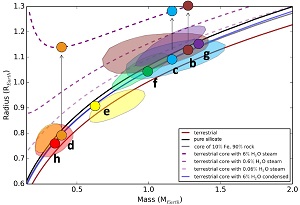
With seven rocky planets on temperate orbits, of which three are considered to be in the habitable zone, the TRAPPIST-1 system is one of the best characterized and fascinating planetary systems. Based on knowledge of their masses, radii, and densities, previous studies inferred that most of the seven planets are likely enriched in volatiles (e.g., water), up to tens of percent of the planetary masses. However, the three innermost planets (TRAPPIST-1b, c, and d) receive more irradiation from the star than the runaway greenhouse limit, implying that all of their putative water reservoir could actually form a steam atmosphere, and it has been shown in a recent study by Turbet et al. (2019) that this situation leads to strong atmospheric expansion. Here the authors apply these concepts to propose revised mass-radius relationships for this class of planets, providing, in particular, empirical formulas for the thickness of the H2O steam atmosphere as a function of planet core gravity and the radius, water content, and irradiation. For a given water-to-rock mass ratio, these new mass-radius relationships lead to planet bulk densities that are much lower than if water is assumed to be in its condensed form, implying that the latter assumption considerably overestimates the planets' bulk water endowment. The application to the TRAPPIST-1 system implies that when assuming a terrestrial core composition, TRAPPIST-1b, c, and d can accommodate a water mass fraction of 0.1-2 %, at most, and perhaps even much less.
Unexpected late-time temperature increase observed in the two neutron star crust-cooling sources XTE J1701-462 and EXO 0748-676 (Parikh et al.)
- Details
- Published on 08 June 2020
Vol. 638
1. Letters
Unexpected late-time temperature increase observed in the two neutron star crust-cooling sources XTE J1701-462 and EXO 0748-676
During an X-ray outburst, a transient neutron star accretes matter which then heats the crust. After the outburst has ended, the neutron star cools, providing invaluable insights into the properties of the crust. Without further sources of heat, the compact object is expected to continue to cool. This simple physical picture is challenged by the observations presented in this Letter, in which a late time rise in temperature has been observed in two transient systems years after the outburst ended. As the authors have stated, this rise in temperature is unexplained. Further studies should lead to a deeper understanding of the dense matter physics.
Mt. Wendelstein imaging of comet 41P/Tuttle-Giacobini-Kresak during the 2017 perihelion arc (H. Boehnhardt et al.)
- Details
- Published on 29 May 2020
Vol. 638
10. Planets and planetary systems
Mt. Wendelstein imaging of comet 41P/Tuttle-Giacobini-Kresak during the 2017 perihelion arc
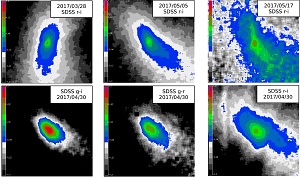
Comet 41P/Tuttle-Giacobini-Kresak (41P), a Jupiter family comet with three discoveries over about 100 years, is in a short-periodic orbit around the Sun with the perihelion close to the Earth distance. The 2017 apparition of 41P offered a long-lasting visibility of the comet at a close distance to Earth. The four month-long imaging campaign with the 2 m telescope at the Mount Wendelstein Observatory was aimed at characterizing dust activity and nucleus properties of the comet. Using a new analysis method of the inner coma flux, we derived a small mean equivalent radius of about 600 m for the nucleus with an unusual body axes ratio that is higher than two. The nucleus rotation axis was determined from the geometric appearance of coma structures, which were enhanced in the images. A long-lasting coma fan was produced by an extended region at high latitudes on the slowly rotating nucleus, whereas isolated jets originated from narrow, low latitude active regions on the nucleus. The dust activity of 41P, despite being difficult to quantify exactly because of an unknown phase function correction for the comet, indicates a steep radial profile that falls off with an increasing distance from the Sun. Colors and flux profiles provide evidence for dust fragmentation in the inner coma of the comet. A singular outburst event created various dust structures in the coma. The outburst came from an extended region on the nucleus and was due to either a landslide on the nucleus or a sudden material release from a subsurface pocket of volatile ice.
Liverpool-Maidanak monitoring of the Einstein Cross in 2006–2019. I. Light curves in the gVrRI optical bands and microlensing signatures (Goicoechea et al.)
- Details
- Published on 19 May 2020
Vol. 637
4. Extragalactic astronomy
Liverpool-Maidanak monitoring of the Einstein Cross in 2006–2019. I. Light curves in the gVrRI optical bands and microlensing signatures
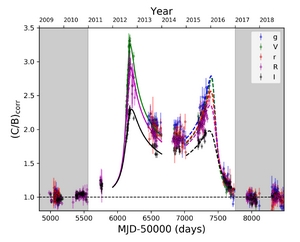 The Einstein Cross is a gravitationally lensed quasar at z= 1.695. The quasar QSO 2237+0305 is lensed in four images (A, B, C, and D) that are arranged like a cross around the nucleus of a nearly face-on spiral galaxy (the lens) at z =0.039. In addition to the global strong lensing, compact objects, such as stars, in the lensing galaxy produce microlensing and differential magnification of the four images. In order to gain more insight into these compact objects, the authors monitored the Einstein Cross using 4 374 optical frames (gVrRI) taken with the 2 m Liverpool and the 1.5 m Maidanak telescopes, over the 2006-2019 period, yielding light curves of the four images A-D. The differences between A-D light curves reveal strong microlensing signatures, affecting the C image, which experienced a double caustic crossing. The UV continuum of the quasar is modeled by a standard accretion disk of radius R, which increases with wavelength as a power law of exponent alpha=1.33. More monitoring data are required to draw a more robust conclusion.
The Einstein Cross is a gravitationally lensed quasar at z= 1.695. The quasar QSO 2237+0305 is lensed in four images (A, B, C, and D) that are arranged like a cross around the nucleus of a nearly face-on spiral galaxy (the lens) at z =0.039. In addition to the global strong lensing, compact objects, such as stars, in the lensing galaxy produce microlensing and differential magnification of the four images. In order to gain more insight into these compact objects, the authors monitored the Einstein Cross using 4 374 optical frames (gVrRI) taken with the 2 m Liverpool and the 1.5 m Maidanak telescopes, over the 2006-2019 period, yielding light curves of the four images A-D. The differences between A-D light curves reveal strong microlensing signatures, affecting the C image, which experienced a double caustic crossing. The UV continuum of the quasar is modeled by a standard accretion disk of radius R, which increases with wavelength as a power law of exponent alpha=1.33. More monitoring data are required to draw a more robust conclusion.
Tracing the anemic stellar halo of M101 (In Sung Jang et al.)
- Details
- Published on 28 April 2020
Vol. 637
4. Extragalactic astronomy
Tracing the anemic stellar halo of M101

Cosmological models of galaxy formation show that disk galaxies are embedded in extended stellar halos. However, previous studies of some disk galaxies have failed to detect this stellar component. This was the case of the prototypical disk galaxy M101, for which it has been suggested that it lacked this stellar halo component. In using optical imaging with the Hubble Space Telescope (HST), it is now possible to resolve M101 stars and map their halo out to 70 kpc from the center. The new color-magnitude diagrams reach down to two magnitudes fainter than the tip of the red giant branch (RBG). This allowed HST to trace the M101 halo component down to very faint surface brightness (μg ≈ 34 mag arcsec−1). The stellar population is found to be similar to that of metal-poor globular clusters in the Milky Way based on the mean color of the RGB stars. The HST star counts also allowed the authors to measure the total halo mass of M101, which is small in comparison to! Well studied galaxies, such as the Milky Way or M31. Indeed, the comparison with the other six galaxies from the same survey shows that M101 has an anemic stellar halo.
Deep Horizon: A machine learning network that recovers accreting black hole parameters (van der Gucht et al.)
- Details
- Published on 22 April 2020
Vol. 636
15. Numerical methods and codes
Deep Horizon: A machine learning network that recovers accreting black hole parameters
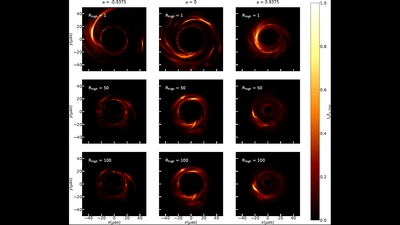
In April 2019, the Event Horizon Telescope released the first ever image of the shadow of a black hole at the center of the M87 elliptical galaxy, dominating the Virgo cluster. These observations were made possible by eight ground-based radio telescopes spread all over the world. In this paper, van der Gucht et al. present a combination of two neural network algorithms that are able to recover the physical parameters of the accreting black hole based on the observed shadow. To train these networks, they used a set of general relativistic simulations of accretion disks around massive black holes, testing a grid of parameters. They discover that with the current resolution, only the mass of the black hole and the mass accretion rate can be safely recovered. To derive further parameters, such as the black hole spin, we would need to go beyond the Earth-based set of radio telescopes and include a space-based radio mission.
Is there NaI in the atmosphere of HD 209458b? Effect of the centre-to-limb variation and Rossiter-McLaughlin effect in transmission spectroscopy studies (Casasayas-Barris et al.)
- Details
- Published on 03 April 2020
Vol. 635
10. Planets and planetary systems
Is there NaI in the atmosphere of HD 209458b? Effect of the centre-to-limb variation and Rossiter-McLaughlin effect in transmission spectroscopy studies

HD209458b has a special status among exoplanets. It was the first one shown to transit in front of its star and the first one for which an atmospheric signature (atomic sodium) was reported from spectroscopy in 2002, which was seemingly confirmed in subsequent observations. Transit spectroscopy in which spectra in- and off-transit are rationed to extract the transmission spectrum of the planet's atmosphere is simple in its principle, but it may be fraught with complex effects. Those include the nonuniform brightness of the star (center-to-limb variations, CLV) and the Rossiter-McLaughlin (RM) effect in which the planet progressively occults regions of the star with different line-of-sight velocities, causing a shift in the stellar lines as the transit proceeds. In focusing on the sodium D lines in HD209458, Casasayas-Barris present a detailed modeling of these effects and demonstrate that, even the lack of any absorption by the planet's atmosphere, can lead to apparent spectral features in transmission spectroscopy. Most remarkably, calculations indicate that those features may predominantly show up in emission. By comparing model predictions to archival data from HARPS-N and CARMENES, they conclude that transmission spectra actually reveal no detectable Na I atmospheric absorption due to the planet. The study also provides a natural explanation for the Na I emission features seen in earlier HST/STIS observations of the system, which had been previously interpreted to be due to telluric contamination. More broadly, this work indicates the need for careful reassessment of some of the atmospheric identifications based on exoplanet transit spectroscopy.
The origin of tail-like structures around protoplanetary disks (Vorobyov et al.)
- Details
- Published on 01 April 2020
Vol. 635
6. Interstellar and circumstellar matter
The origin of tail-like structures around protoplanetary disks

The origin of the enigmatic tail-like structures recently detected around the disks of several young stars was studied using numerical hydrodynamics simulations. Two possible formation mechanisms were considered: ejections of gaseous clumps from dynamically unstable protostellar disks and close encounters between quiescent protoplanetary disks and intruder stars. The authors demonstrate that ejected clumps produce a unique type of tail that is characterized by a bow-shock shape. Such tails originate from the supersonic motion of clumps ejected through the dense envelope that often surrounds young protostellar disks. On the other hand, close encounters between an intruder star and a protoplanetary disk produce three types of such tail-like structures. The authors define these as pre-collisional, post-collisional, and spiral tails. These tails can be distinguished from one another by particular features of the gas and dust flow in and around them. The estimated mass of gas and dust in the tail can amount to tens of Jovian and Earth masses, respectively, which is higher than what was inferred for similar structures in SU Aurigae and FU Orionis. The authors argue that tail-like structures around protostellar and protoplanetary disks can be used to infer interesting phenomena, such as clump ejection or close encounters. In particular, the bow-shock morphology of the tails could point to clump ejections as a possible formation mechanism.
Hidden magnetic fields of young suns (Kochukhov et al.)
- Details
- Published on 23 March 2020
Vol. 635
7. Stellar structure and evolution


